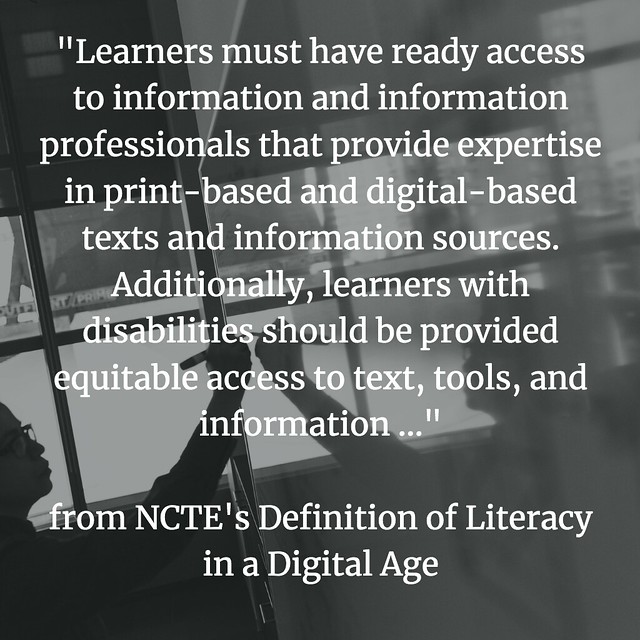I’m slowly reading and digesting, and appreciating, the National Council of Teachers of English revised definition of Literacy in a Digital Age, and I am appreciating the depth of the inquiry.
Issues of access often take a back seat in discussions about digital literacies but here, in this definition, NCTE tackles it head-on early in its inquiry. And it’s not just who has what available — in other words, does the digital divide create unseen barriers for students — but also, how students with disabilities can access the same information and technology and tools as their peers.
I remember having a long discussion in a course about “alt text” on images via Twitter and other social networking platforms, and many of us worked on a public statement, urging Twitter to make the option for “alt text” writing on images for screen readers a default (it was an option one could turn on but I think it is now the default, so … progress). I am also thinking of how text-to-speech options, and how color-coding/highlighting/organizational possibilities, and how speech-to-text options all open the door to all of our students in terms of access.
Socio-economics play a role, too. I’ve done consulting work in schools where the computers are used for one thing: testing. Technology was only means of data gathering, and not a way for students to gather information and compose in different media. Student agency was nearly absent for the sake of constant testing.
One question within the NCTE definition seemed rather intriguing, as it brings to the surface an awareness of gaps. It asks:
Do learners recognize information gaps or information poverty?
and the follow up question:
Do learners advocate for their own individual and community’s access to texts and tools?
I wonder how teachers can best make those gaps visible to all students — this gets at the heart of equity — and how to help students advocate for places where the gaps exist? It seems to me that collaborations between classes — ie, Connected Learning principles — and better educator awareness might address this kind of question, but the fact is that for most of us, we don’t know what we don’t have because we made do with what we’ve got.
I think we all know we need to do better — with better-funded school libraries and information systems (that open doors for access, not just surveil our students), and classrooms, and teacher programs that incorporate these ideals in meaningful ways.
I was thinking of the mission statement of our Western Massachusetts Writing Project as I was reading this section of the Digital Literacies definition, as access and equity and social justice are front and center in all the work we do with students and teachers and school districts.
Peace (thinking),
Kevin
